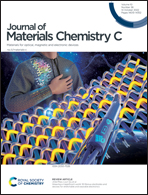Efficient pure near-infrared organic light-emitting diodes based on tris(2,4,6-trichlorophenyl)methyl radical derivatives†
Abstract
Near-infrared emission has received increasing attention due to its application in optical communication, night-vision readable displays, remote sensing and medical diagnosis. However, near-infrared molecules suffer from the intrinsic limitation of low luminescence efficiency due to the energy-gap law. Thus, the simultaneous realization of near-infrared (NIR) emission and high luminescence efficiency is a challenge. Herein, two near-infrared fluorescent radicals, TTM-3PDMAC and TTM-PDMAC, based on 9,9-dimethyl-10-phenyl-9,10-dihydroacridine (PDMAC) with different linking positions were developed. Their thermal, photophysical, and electrochemical properties and device characteristics were investigated. TTM-3PDMAC exhibits a red shift and higher luminescence efficiency compared to its isomeric counterpart TTM-PDMAC. This is because TTM-3PDMAC has a much smaller torsion angle and planar conformation between PDMAC and TTM, resulting in a smaller band gap but higher efficiency. At the same time, an OLED based on TTM-3PDMAC achieved a maximum external quantum efficiency (EQE) of 3.1% with an emission peak at 830 nm, which is among the highest values of OLEDs with an emission peak beyond 800 nm based on metal-free emitters. This study demonstrates the effectiveness of the isomeric strategy for obtaining efficient NIR luminescent radicals.

- This article is part of the themed collection: Journal of Materials Chemistry C HOT Papers


 Please wait while we load your content...
Please wait while we load your content...